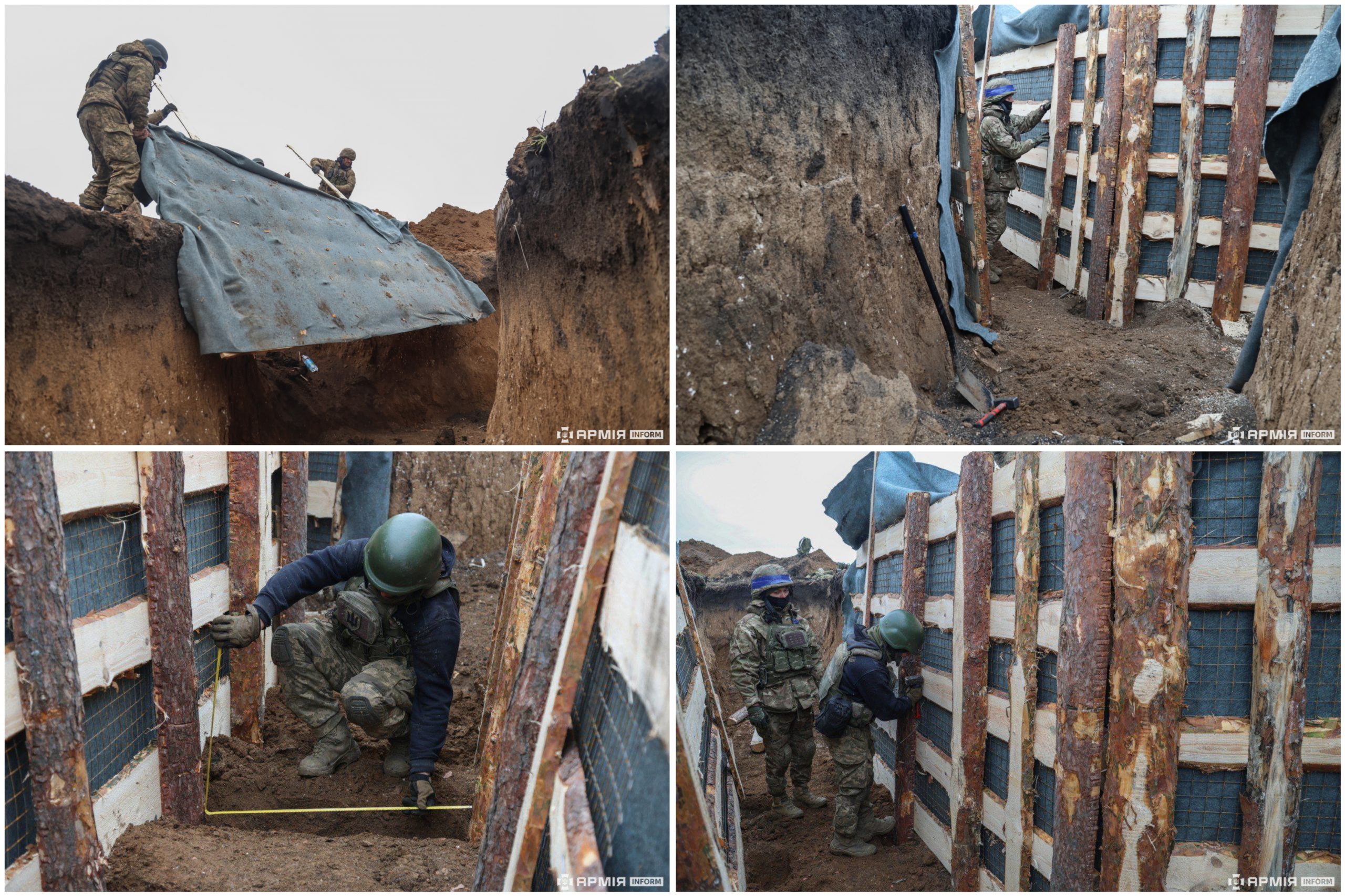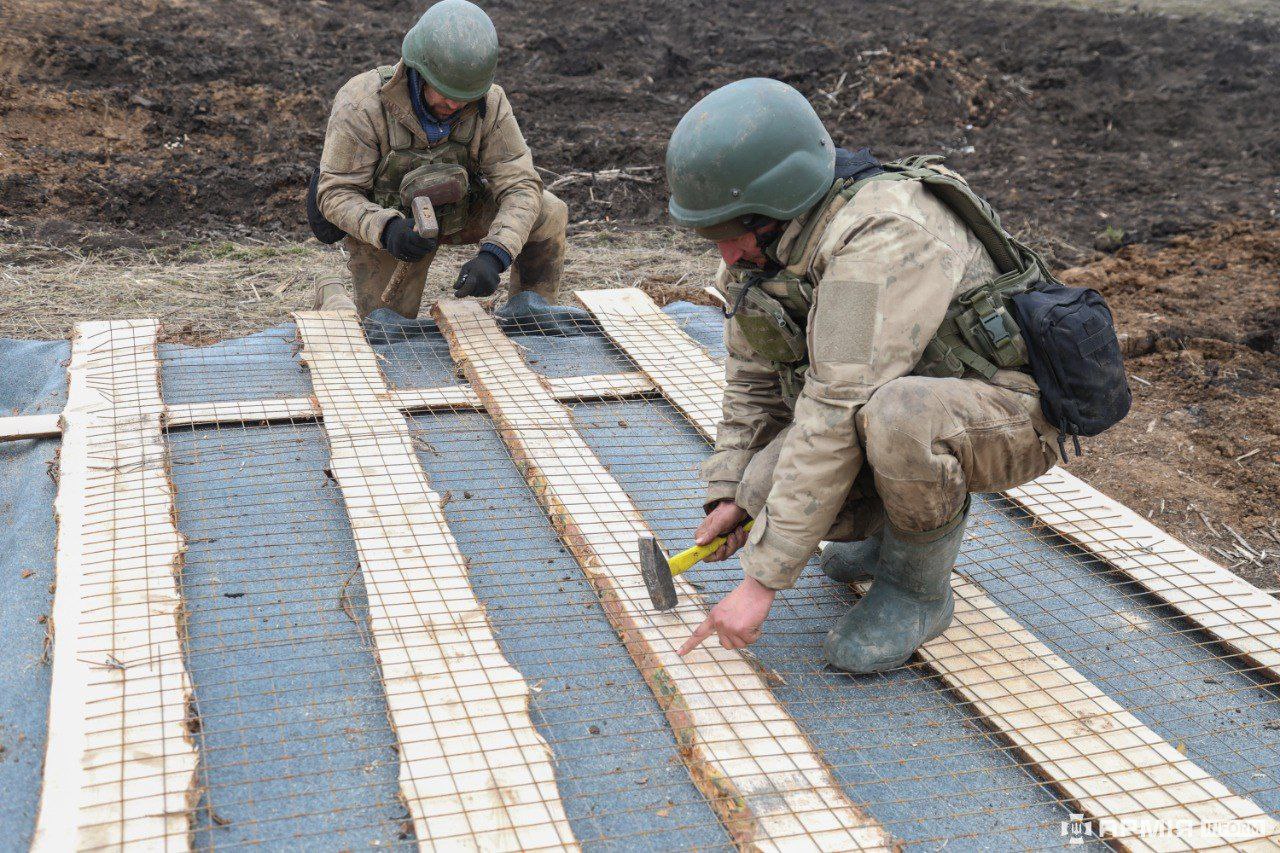Ukraine is adding hundreds of kilometers of new defenses, including trenches, strong points, pillboxes, bunkers and rows of anti-armor dragons' teeth.
To do so, they are employing state of the art materials and construction techniques to make the the new works stronger and to build them faster. JL
Emmanuel Grynszhpan reports in Le Monde with additional detail from Militarnyi:
A few kms from the front, Ukrainian military engineers are digging trenches and setting up rows of 'dragon's teeth.' Trenches hundreds of meters long have appeared in the freshly thawed soil. “During WWII, trenches were 1.5 meters by 80 centimeters, but now we make them 2 meters deep and 1 meter wide. Another half-meter parapet is poured on top. We use geotextiles, mesh, boards, and timbers in the construction.” Corners are reinforced with pillars. Pillboxes are covered. Exits have smooth elevation changes to avoid injuries during rapid movement. At each entrance and exit, a well is dug to collect water. "We make spacers for structural strength and installation of anti-drone protection."A few kilometers from the front, Ukrainian military engineers are racing against time to thwart the Russian advance into the Donetsk region, digging trenches and setting up rows of 'dragon's teeth' or 'Czech hedgehogs' to block the approaching enemy tanks.Three kilometers behind the Ukrainian front line, trenches hundreds of meters long have recently appeared in the freshly thawed soil. "This round anti-tank trench was dug by a specialized MDK-3 excavator," said Andrii, a lean, sad-eyed Ukrainian soldier, with pride. This 34-year-old military engineering officer has shouldered the responsibility for building defensive lines to protect the lives of thousands of his comrades, along one of the most intensely embattled sections of the front.
Citing security concerns, the officer insisted that neither his exact rank in the military hierarchy, nor the name of his brigade, nor its area of operations be mentioned. The relentless explosions of shells and rockets in the surrounding area stood as clear proof of the efforts of Russian artillery to, as said in military jargon, "soften up" the Ukrainian defenses.
The officer didn't react to the explosions, but his jitteriness was palpable. At the slightest suspicious noise, he would freeze, focus on his hearing and scan the clear sky. It was the buzzing sound emitted by the FPV kamikaze drones that made him nervous. "Enemy drones fly non-stop in this area," he said. "Their priority targets are armored vehicles and engineering equipment, but they also pounce on groups of soldiers." We were standing in a group of three, wearing helmets and bulletproof vests. "We have to split up immediately if an FPV approaches. He [the Russian pilot] might give up on his attack," Andrii said. Unless the drone's battery was drained, in which case its pilot would send it to any target within range.
Emerging from the trench, the officer ran to another one that had been dug further away, so as not to remain in the open any longer than necessary. "Notice the difference with this ditch, dug by a regular excavator. The edges are vertical and the loose earth sags over time. It's less effective at impeding tanks," he said. At the rear of the MDK-3 excavator, a rotating blade drills into the ground and displaces the dirt.
The military is working on the construction of a platoon stronghold on the frontier of the defense of the operational zone of one of the operational and tactical groups. The exact location of the construction is not disclosed for security reasons.
The news agency said that, given the nature and realities of modern warfare, trenches are made wider and higher to allow for a gap in equipment, carrying a wounded person on a stretcher, etc.
“During the Second World War, the depth and width of the trenches were 1.5 meters by 80 centimeters, but now we make them 2 meters deep and about 1 meter wide. And another half-meter parapet is poured on top. At the same time, we cannot make it wider, because the trenches will become more vulnerable to shelling. We use geotextiles, mesh, boards, and timbers in the construction,” says Leonid, an officer of the engineering troops.
The corners of the trench are reinforced with additional pillars and spacers. Pillboxes are covered with wooden boards. The troops also equip exits with smooth elevation changes to avoid injuries during rapid movements.
“The height of the covered area is approximately 2 meters 30 centimeters. There is a strong frame, transverse and longitudinal beams, and the floor has two layers: the first layer is half a meter of ground, and the second layer is the same.”
All of this is disguised. In the event of shelling, you can quickly move to such areas from firing positions. At each entrance and exit, a well is dug to collect water so that it does not flow into the blocked area.
“The advantage of working with wood is the speed, but the disadvantage is its short life (it needs to be repaired after 2 years – Ed.). Over the uncovered part, we make spacers at the bottom and top for structural strength and installation of anti-drone protection. In our approach, we have taken into account the advice of infantry commanders,” the military engineers said.
As previously reported, in January of this year, the Ukrainian government allocated additional funds for the construction of fortifications.
It regards UAH 17.5 billion, which will be used to build engineering and fortification structures, relevant equipment, and non-lethal fencing systems.
The funds are allocated to the relevant state agencies and regional state administrations.























2 comments:
I just discovered a new universe in space waves! The music, graphics, and gameplay are all amazing. It feels like I'm lost in a colorful dream.
level devil 2 contains numerous increasingly difficult levels. Players face new and hard challenges in each stage.
Post a Comment